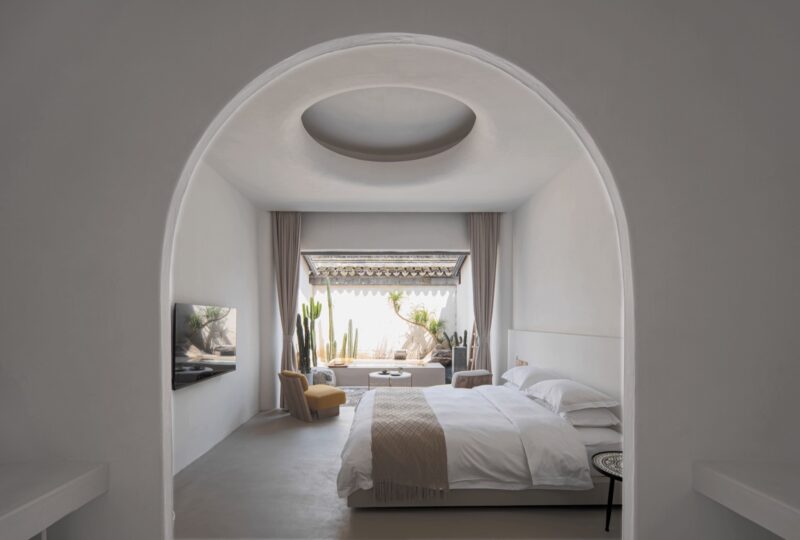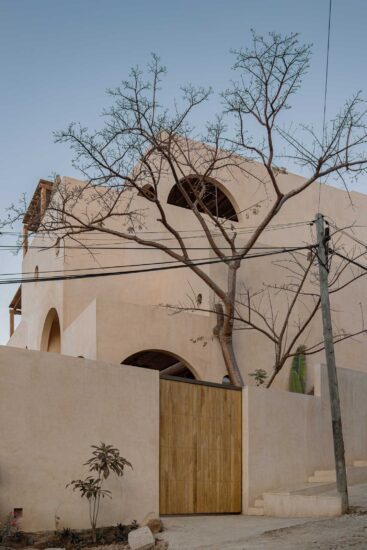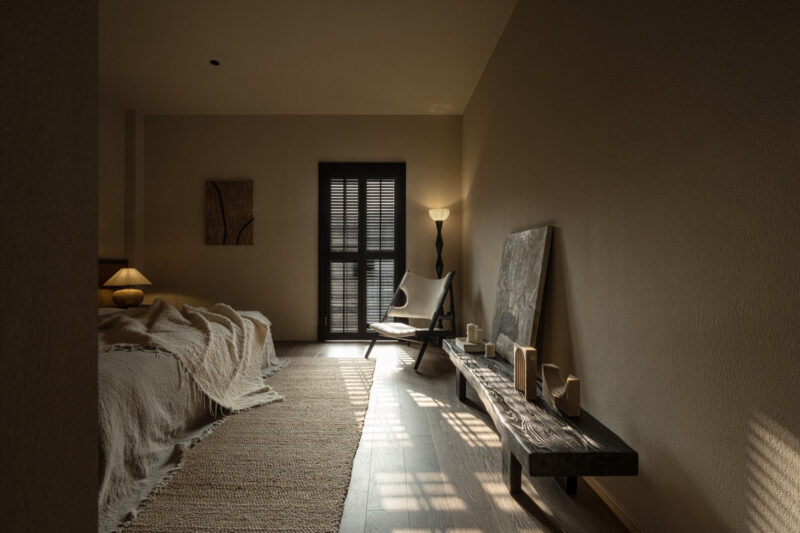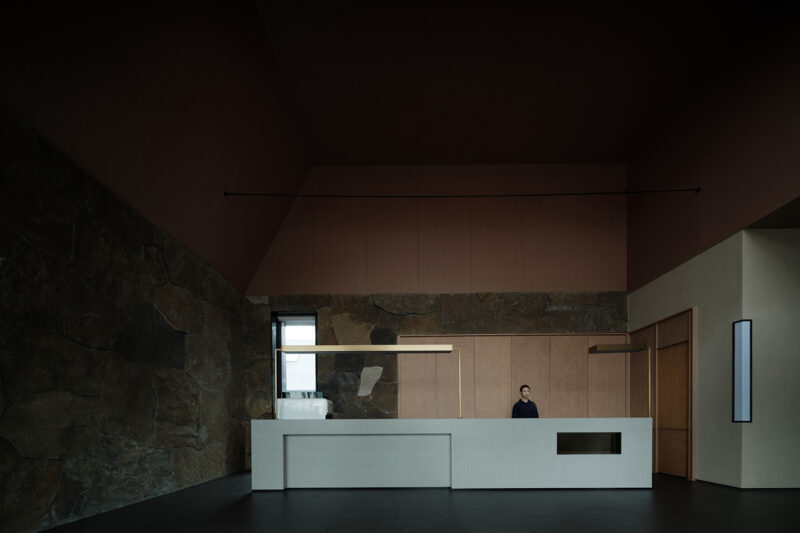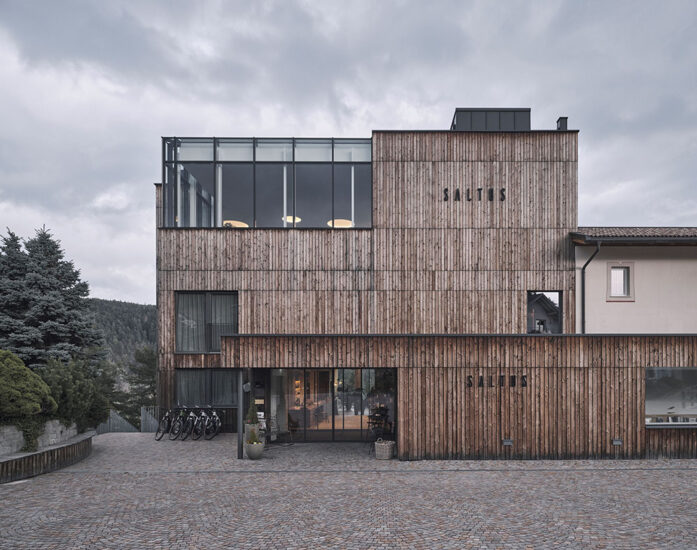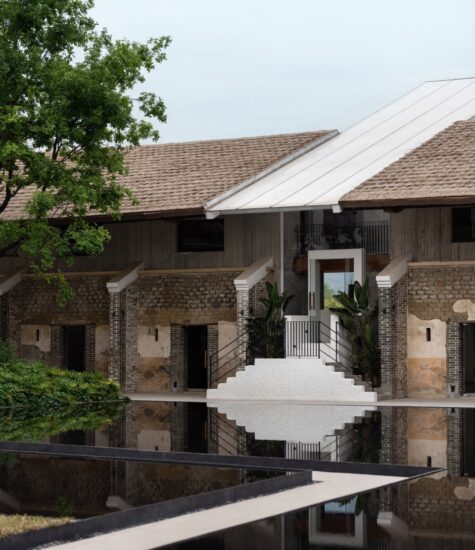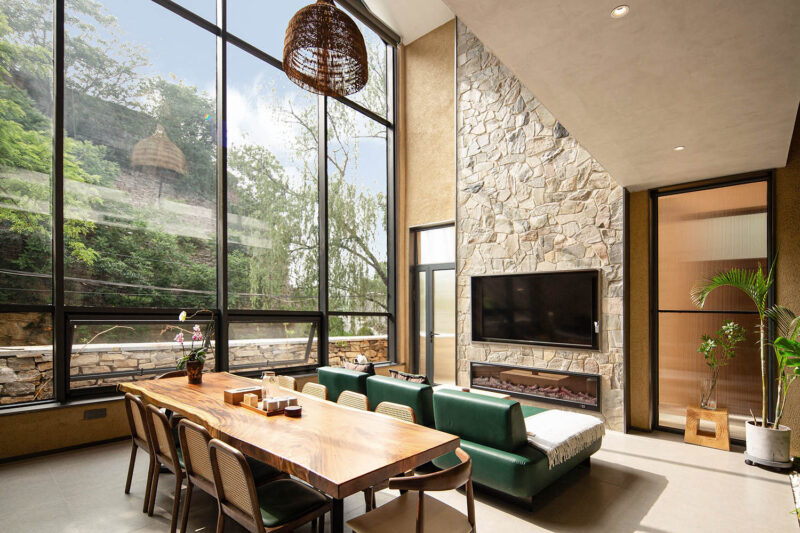全球设计风向感谢来自零壹城市建筑事务所的民宿项目案例分享:
时空回廊丨临海余丰里民宿
Time and Space Corridor_ Linhai Yufengli Homestay
∇ 四合院书馆,摄影:吴清山Courtyard Bookstore, photo: Wu Qingshan
临海余丰里民宿位于浙江临海台州府城古镇的赤城路老街口,是一个建筑面积近4000平方米的改造项目,由零壹城市建筑事务所从建筑、室内、软装到VI系统一体化设计。它的前身是一间百年老当铺,由一座具有100多年历史的四合院、两栋60年历史的砖混工业用房,以及两栋30多年历史的旧仓库组成。
Yufengli Homestay is located at the corner of Chicheng Road in the ancient town of Linhai, Zhejiang Province. It is a reconstruction project of nearly 4,000 sq.m, which architecture, interior, soft decoration and VI system all designed by LYCS Architecture . Its predecessor is a century-old pawnshop, consisting of a courtyard with a history of more than 100 years, two brick-concrete industrial houses with a history of 60 years, and two old warehouses with a history of more than 30 years.
∇ 主入口界面,摄影:吴清山Main Entrance, photo: Wu Qingshan
整个台州府城古镇仍然保留着大量历史古建筑,而作为项目所在地的紫阳老街还延续着传统的街坊生活方式,这里是临海千年古城的文化血脉,是古城遗址的缩影,就像是一个活的历史建筑馆。项目起初就提出了挑战:面对同时存在3种不同年代的建筑,跨越百年的历史,新改造的介入如何让旧与新、传统与未来的对话创造全新的居住空间体验?这不仅是这一项目的核心思考,也是零壹城市对新居住模式、城市更新的进一步探索。
The entire ancient block still retains a large number of historical buildings and continues the traditional neighbourhood lifestyle. It’s like a living historical building museum. At the beginning of the project, a challenge was raised: how can the new renovation create a new living space experience in the face of buildings of three different ages? This is not only the core thinking of this project, but also the further exploration of the new residential model and urban renewal by LYCS Architecture.
∇ 内庭院,摄影:吴清山After: Inner Courtyard Landscape, photo: Wu Qingshan
时空回廊 Space-time corridor
并置不同年代建筑历史传承的“时空回廊”
Space-time corridors which make historical architectures of different ages coexist.
设计以“时空回廊”是作为改造理念的主线,串联起场地现有清末民初、解放后和改革开放三个不同历史时代的建筑。这些老建筑虽已有些残败,但仍保留着在它们的年代,对于建筑美感和空间功能的理解,砖木间诉说着不同的历史故事。设计试图还原并且强化在这同一天地中历史时空的碰撞,让每一个不同年龄段、不同背景的人来到这里,都能找到触动内心的属于一个时代的理解。
The design takes “space corridor” as the main line of concept, and connects the existing buildings in the three different historical eras in the late Qing Dynasty, early Republic of China, post-liberation and reform and opening up. Although these old buildings have been somewhat ruined, they still retain their unique aesthetic and spatial functions. The design attempts to restore and strengthen the contrast of different historical buildings, so that every person of different ages and backgrounds can find an understanding that touches their hearts.
∇ 内庭院,摄影:吴清山After:Inner Courtyard Landscape, photo: Wu Qingshan
∇ 内庭院水景,摄影:吴清山Inner Courtyard Landscape, photo: Wu Qingshan
∇ 内庭院,摄影:王宁Inner Courtyard Landscape, photo: Wang Ning
面对不同年代的老建筑,保留其现有的外观并采用为其“量身打造”的改造策略。对于100年历史的四合院,修旧如旧,尽可能的还原属于历史院落的生气,在细节上保留曾经的“当铺记忆”,再为其注入新的生命力;对于60年历史的两幢工业遗存建筑,保留一部分历史和工业痕迹,在整体建筑修缮的同时,通过局部加入当代空间感受和空间使用方式,产生一种戏剧化的空间对话。
Facing the buildings of different ages, retain its existing appearance and adopt a retrofit design strategy for it. For the 100-year-old Siheyuan, the restoration restored the vitality of the historical courtyard as much as possible, retaining the former “pawnshop memory” in details, and injecting new vitality into it. For the two industrial buildings with a history of 60 years, part of the historical and industrial traces are retained. While the overall building is being repaired, the contemporary space function is partially added to create a dramatic spatial effect.
∇ 屋顶花园视角,摄影:吴清山Overview from Roof Garden, photo: Wu Qingshan
对于20年历史的仓库建筑,在保留建筑原有框架的基础上,进行较大幅度创新动作,从外观便以锈金属板特立呈现,让建筑在透出更多现代的气息。三种不同年代的交织,在内庭院环绕,展现出三种不同历史声音的“时空回廊”。
For 20-year-old warehouse buildings, more innovations are made on the basis of retaining the original structural framework. From the exterior, it is presented with rusty metal plates, allowing the building to reveal a more modern atmosphere. The interweaving of three different ages, surrounded by the inner courtyard, reveals three different historical “space corridors”.
∇ 从建筑外廊看老城,摄影:吴清山Overview, photo: Wu Qingshan
城市客厅 Urban living room
将民宿公共功能拓展为城市街道生活的延伸
Expanding public function spaces into extensions of urban life
∇ 咖啡吧,摄影:吴清山Cafe, photo: Wu Qingshan
四合院的改造设计,在更多的保留现状的基础上加以修缮,让其作为民宿公区的同时,也打造为面向城市居民和游客开放的“城市客厅”。在内部选择局部空间进行一二层通高设计,作为或书馆、或众创空间、或会客、或咖啡吧等功能使用,也是设计中具有反差力的记忆点,让局部的改变完成四合院整体的复苏。
The reconstruction design of the courtyard house was repaired on the basis of retaining as much of the status quo as possible. While making it a homestay area, it is also created as an “urban living room” open to urban residents and tourists. A part of interior space was selected for a two-story high-height design. It was used as a bookstore, guesthouse, or coffee bar, etc.
∇ 四合院书馆,摄影:吴清山Coutyard Bookstore, photo: Wu Qingshan
∇ 四合院咖啡吧和餐厅,摄影:吴清山Coutyard Cafe & Dining Room, photo: Wu Qingshan
“城市客厅”把原来分裂开来的城市公共活动整合在一起,对内作为民宿的服务功能,提升居住的配套附加值;对外向城市开放,成为城市人群活动、聚会、交友、学习等聚集地。而同样重要的是,通过公共区域与民宿区域的分区管理,依旧保证民宿区域的私密性与专属性。
“Urban living room” integrates the original messy urban public activities together. The internal service function as a homestay enhances the added value of living facilities, at the same time, it is open to the city to become a gathering place for urban crowds to make activities, make friends, and learn. It is also important that the privacy of the homestay area is still guaranteed through the partition management of the public area and the homestay area.
∇ 四合院楼梯空间,摄影:吴清山Coutyard Stairs, photo: Wu Qingshan
∇ 四合院二层多功能厅,摄影:王宁Coutyard Multifunction Space, photo: Wang Ning
∇ 四合院会议厅的“当铺记忆”细节,摄影:王宁“Pawnshop Memory” Details, photo: Wang Ning
居住对话 Experiential living
以使用者行为作为中心出发的居住空间体验Experiential living space based on user behavior
客房室内空间设计不再以传统酒店的“居住”功能为核心,而是真正站在使用者角度,突破使用功能禁锢,营造场景下的居住体验,将使用者行为作为核心出发点。空间作为身心经验的载体,以不同历史年代建筑的体验感受为主题,为每个客房量身定制身心之旅。通过设计把某一特定行为进行放大,用新的方式来创造人与历史空间的对话。
The interior design of guest rooms is no longer centered on the “living” function of ordinary hotels. Instead, the user behavior is the core to create a living experience in the scene. The space serves as the carrier of physical and mental experience, and the theme of the guest rooms is the experience of buildings in different historical ages. Amplify a specific behavior through design, and create a new way of dialogue between man and historical space.
∇ 90年代建筑客房,摄影:吴清山90s Guest room, photo: Wu Qingshan
四合院客房:“星空下”的历史畅想Courtyard Guest Room: Historical Imagination “Under the Sky”
老建筑原有的木梁柱结构自然、纯粹,为保留其本初的美感,设计首先将老建筑的木结构修复和直接裸露作为室内空间的自然划分和主基调,局部点缀既与之相和谐又增加现代氛围的家具。屋顶的木椽石瓦被打开一方天光,在引入自然光线的同时,营造将使用者带入“星空下”百年历史畅想的居住美感中。
The original wooden beam and column structure of the old building is natural and pure. In order to retain its original beauty, the design first used the restoration and direct exposure of the wooden structure as the division and main tone of the interior space. The furniture was locally harmonious and added a modern atmosphere. While opening a pane on the roof to introduce natural light, it creates a living aesthetic that brings users into the imagination of the century-old history.
∇ 四合院“星空下”客房,摄影:吴清山Courtyard Guest Room, photo: Wu Qingshan
∇ 四合院客房,摄影:吴清山Courtyard Guest Room, photo: Wu Qingshan
∇ 四合院客房,摄影:吴清山Courtyard Guest Room, photo: Wu Qingshan
60年代建筑客房:50%传统+50%现代60s Guest Rooms: 50% Traditional + 50% Modern
60年代建筑客房的室内呼应建筑的改造策略和氛围,在”一半”传统结构中注入”一半”的现代梳理,保留了具有历史质感的青砖和混凝土结构,将主体居住功能置入客房的中心位置,给使用者足够的空间留白体验。
The interior of the guest room echoes the reconstruction strategy and atmosphere of the 60s building, injecting “half” of modern combing into the “half” of the traditional structure. The brick and concrete structure with historical texture is retained, and the main living function is placed in the center of the guest room, giving the user a sense of sufficient space.
∇ 60年代建筑客房,摄影:吴清山60s Guest Rooms, photo: Wu Qingshan
∇ 60年代建筑客房,摄影:吴清山60s Guest Rooms, photo: Wu Qingshan
∇ 60年代建筑公区,摄影:吴清山60s Guest Rooms, photo: Wu Qingshan
∇ 楼梯空间,摄影:吴清山Stairs, photo: Wu Qingshan
90年代建筑客房:20%传统+80%现代90s Guest Rooms: 20% Traditional + 80% Modern
90年代建筑客房中的传统元素被选择性筛留,转变为局部的细节展现,大量木色空间包裹营造出更为现代式温馨的居住氛围,为追崇更加时尚简洁居住感受的使用者提供选择。
The traditional elements in the architectural rooms of the 1990s were selectively screened and transformed into partial details. A large number of wood-colored spaces created a more modern and warm living atmosphere, providing users with choices in pursuit of more stylish and simple living experiences.
∇ 90年代建筑客房,摄影:吴清山90s Guest Rooms, photo: Wu Qingshan
∇ 90年代建筑客房,摄影:吴清山90s Guest Rooms, photo: Wu Qingshan
∇ 客房公区,摄影:吴清山Public Space, photo: Wu Qingshan
∇ 客房软装细节,摄影:王宁Soft Decoration Details , photo: Wang Ning
∇ 客房软装细节,摄影:王宁Soft Decoration Details , photo: Wang Ning
∇ 首层总平面图 ©零壹城市建筑事务所Ground Floor Plan ©LYCS Architecture
主要项目信息
项目名称:临海余丰里精品酒店
项目地点:中国 台州 临海
建筑面积:3,298平方米
项目时间:2017-2018 年(设计) 2018-2019年(施工)
设计公司:零壹城市建筑事务所(建筑设计、室内设计、软装设计、VI设计)
设计团队:阮昊、詹远、何昱楼、张秋艳、嵇涵、杨莉、赵一凡、范笑笑、王浩然
合作景观设计:章万清,林海
摄影师:吴清山、王宁
Project name: Linhai Yufengli Homestay
Location: Taizhou Linhai, China
Size: 3,298 sq.m
Project Period: 2017-2018(Design) 2018-2019(Construction)
Design Firm : LYCS Architecture (Architecture, Interior, Soft Decoration and VI Design)
Project Team: RUAN Hao, ZHAN Yuan, HE Yulou, ZHANG Qiuyan, JI Han, YANG Li, ZHAO Yifan, FAN Xiaoxiao, WANG Haoran
Cooperative Landscape Design: ZHANG Wanqing
Photographer: WU Qingshan, WANG Ning



